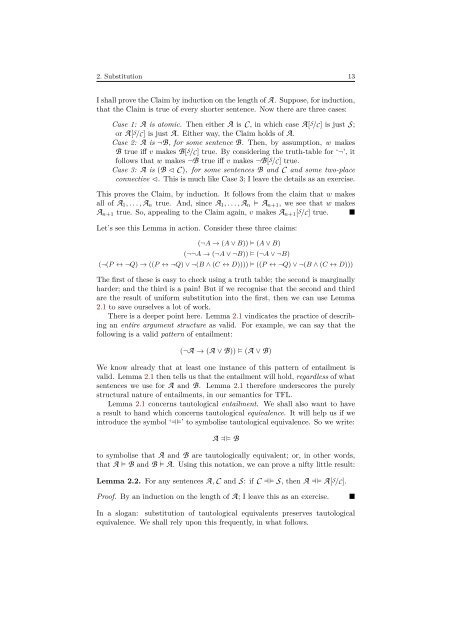Metatheory - University of Cambridge
Metatheory - University of Cambridge
Metatheory - University of Cambridge
You also want an ePaper? Increase the reach of your titles
YUMPU automatically turns print PDFs into web optimized ePapers that Google loves.
2. Substitution 13<br />
I shall prove the Claim by induction on the length <strong>of</strong> A. Suppose, for induction,<br />
that the Claim is true <strong>of</strong> every shorter sentence. Now there are three cases:<br />
Case 1: A is atomic. Then either A is C , in which case A[S/C] is just S;<br />
or A[S/C] is just A. Either way, the Claim holds <strong>of</strong> A.<br />
Case 2: A is ¬B, for some sentence B. Then, by assumption, w makes<br />
B true iff v makes B[S/C] true. By considering the truth-table for ‘¬’, it<br />
follows that w makes ¬B true iff v makes ¬B[S/C] true.<br />
Case 3: A is (B ◁ C ), for some sentences B and C and some two-place<br />
connective ◁. This is much like Case 3; I leave the details as an exercise.<br />
This proves the Claim, by induction. It follows from the claim that w makes<br />
all <strong>of</strong> A 1 , . . . , A n true. And, since A 1 , . . . , A n ⊨ A n+1 , we see that w makes<br />
A n+1 true. So, appealing to the Claim again, v makes A n+1 [S/C] true. ■<br />
Let’s see this Lemma in action. Consider these three claims:<br />
(¬A → (A ∨ B)) ⊨ (A ∨ B)<br />
(¬¬A → (¬A ∨ ¬B)) ⊨ (¬A ∨ ¬B)<br />
(¬(P ↔ ¬Q) → ((P ↔ ¬Q) ∨ ¬(B ∧ (C ↔ D)))) ⊨ ((P ↔ ¬Q) ∨ ¬(B ∧ (C ↔ D)))<br />
The first <strong>of</strong> these is easy to check using a truth table; the second is marginally<br />
harder; and the third is a pain! But if we recognise that the second and third<br />
are the result <strong>of</strong> uniform substitution into the first, then we can use Lemma<br />
2.1 to save ourselves a lot <strong>of</strong> work.<br />
There is a deeper point here. Lemma 2.1 vindicates the practice <strong>of</strong> describing<br />
an entire argument structure as valid. For example, we can say that the<br />
following is a valid pattern <strong>of</strong> entailment:<br />
(¬A → (A ∨ B)) ⊨ (A ∨ B)<br />
We know already that at least one instance <strong>of</strong> this pattern <strong>of</strong> entailment is<br />
valid. Lemma 2.1 then tells us that the entailment will hold, regardless <strong>of</strong> what<br />
sentences we use for A and B. Lemma 2.1 therefore underscores the purely<br />
structural nature <strong>of</strong> entailments, in our semantics for TFL.<br />
Lemma 2.1 concerns tautological entailment. We shall also want to have<br />
a result to hand which concerns tautological equivalence. It will help us if we<br />
introduce the symbol ‘ ⊨’ to symbolise tautological equivalence. So we write:<br />
⊨<br />
A<br />
⊨<br />
to symbolise that A and B are tautologically equivalent; or, in other words,<br />
that A ⊨ B and B ⊨ A. Using this notation, we can prove a nifty little result:<br />
⊨ B<br />
Lemma 2.2. For any sentences A, C and S: if C<br />
⊨<br />
⊨ S, then A<br />
Pro<strong>of</strong>. By an induction on the length <strong>of</strong> A; I leave this as an exercise.<br />
⊨<br />
⊨ A[S/C].<br />
■<br />
In a slogan: substitution <strong>of</strong> tautological equivalents preserves tautological<br />
equivalence. We shall rely upon this frequently, in what follows.
















